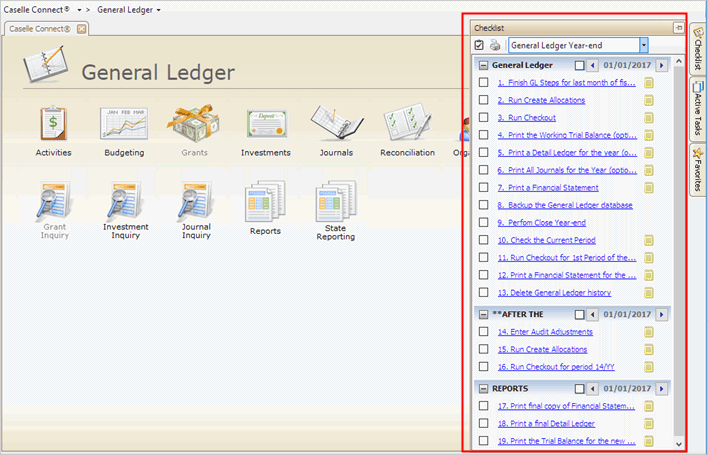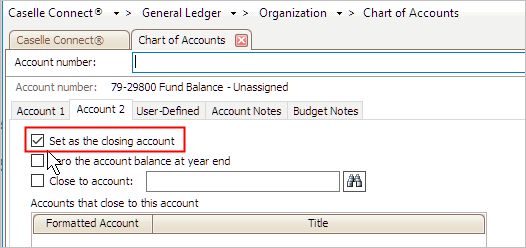How do I close year-end?
Closing the year-end is a step in the Year-end Checklist.
When you are done with the last month of the year, your ready to close the year end. When you run this routine at the fiscal year end or calendar year end will depend on your organization. Closing the year-end is a "soft close", which means Connect will add one year of future dates and you can still enter transactions in the closed year. After you've entered the audit entries and all of the work in the closed year is finished, it's time to close period. Running the Close Period routine is a "hard close" and you won't be able to make any changes to the periods up to and including the closed period.
This help topic will show you where to find the General Ledger Year-end Checklist, show you how to troubleshoot the most common Checkout errors that occur when you close year-end, and teach you how to make audit entries.
Important! Make sure the Organization table is closed before you run this routine.
Watch a video
202005, 2020Mar30
Before you get started
-
Back up the database. See the help topic titled How do I back up General Ledger?
-
Do you have the General Ledger Year-end Close Checklist? Call Caselle support at (801) 243-8275. You'll need to download and install the General Ledger Year-end Checklist.
Where is the GL Year-end Checklist?
Locate the steps you'll need to complete to close the year.
Do this...
1. On the Connect console, click Checklist.

The Checkout fly-out menu displays your default checklist.
2. Use the drop-down list to select Genera Ledger Year-end Checklist.
The General Ledger Year-end Checklist displays in the Checkout fly-out menu.

If the General Ledger Year-end Checklist is not listed in the drop-down list, try clicking Manage Checklists to see if it's available on your workstation.

If the General Ledger Year-end Checklist is missing from Manage Checklists, call Caselle support at (801) 243-8275. They will help you download and install the General Ledger Year-end Checklist.
Published 08Sep2017
Creating allocations
Show me how to create allocations in Period 14/YY (0m42s).
Do this...
1. Open Connect General Ledger > Journals > Create Allocations.
2. Select 14/YY (MM/DD/YYYY) as the Period.
3. Click GO (CTRL+G).
The Allocate Prior Periods warning message displays.
4. Click Yes to create cash allocations for the prior periods.
Your allocations have been created in Period 14/YY.
8Sep2017
Closing year-end
Running this routine will "soft close" the year, which means that you can still access the prior year and make changes to it.
This routine will move the current year forward, check your funds for closing accounts, add one year of future dates, calculate and create beginning balances, and set the dates for grants and activities that have been set up as recurring items.
Show me how to "soft close" the year (4m13s).
Do this...
1. Open Connect General Ledger > Organization > Close Year-end.
2. Click GO (CTRL+G).
The year is closed.
Published 8Sep2017
Adding audit entries to a closed year
In about three or four months after you close the year end, you may receive audit entries from the auditor. You can make those audit entries in Period 14. Next, you'll need to run Recompute Beginning Balances to calculate and create beginning balances for the prior year.
Click here to watch a video (1m40s).
Published 25Aug2017
Closing period
Complete this step after you receive your audit, all of your entries are finished, and everything for the year is done. This is the "hard close" that stops everyone from entering or adjusting transactions in the prior year. When you run this routine, Connect will "hard close" all of the periods up to and including the selected period.
Do this...
1. Open Connect General Ledger > Organization > Close Period.
2. Use the Period drop-down list to select the period to close.
3. Click GO (CTRL+G).
The period is closed.
Published 8Sep2017
Troubleshooting Checkout Errors
Error: [Type] Beginning balance of #,###.00 does not equal prior year ending balance of #,###.00
This error happens when the beginning balances for the fiscal year have not been created. To fix this error, you need to create the beginning balances or recalculate the beginning balances to include changes from the previous year.
Remember to look at the beginning balance for the year being closed. For now, you can ignore the [Type] Beginning Balance of #,###.00 Does Not Equal Prior Year Ending Balance of #,###.00 when it occurs in a future year. See the help topic titled How do I Recompute Beginning Balances?
Error: Book balance does not match bank balance
You may receive this error during the year when the beginning balances for the fiscal year have not been created.
Updated 12Sep2017
Warning Messages
Future Journal Entries, Allocations, GL routines that impact future periods
When you receive a warning message that says what you're doing will affect future periods, please verify that you have selected the correct GL period. If the period is correct, proceed with the process.
Unable to Close Year-end: No closing account for fund ##
If you have created a new fund during the year, one that you just started using or one that you will be using in the next year but haven't used during the current year, the fund still needs to have a closing account. Every fund in Connect must have a closing account. Connect cannot close the year-end until this error is fixed.
Watch a video to see how to fix the No Closing Account Fund error (2m5s)
To fix this error...
1. Write down the fund number that's missing a closing account.
The warning message that displays on the screen when you run Close Year-end will include the fund number.
2. Open Connect General Ledger > Organization > Chart of Accounts.
3. Look up the closing account for the fund.
What if I don't know the closing account?
Click Search (F9) and then right-click on the Search form. Select the Column Chooser and then click to select the column titled Closing Account and drag it onto the search form. Now, click the Closing Account column header twice to show closing accounts at the top of the list.
4. Click to select the Account 2 tab.
5. Click to select the checkbox titled Set As the Closing Account.

6. Click Save (CTRL+S).
The fund is assigned to a closing account.
Updated 12Sep2017
FAQs
Can I close my year-end even though I haven't closed my final month of the year?
Yes, you can close out the year and still retain prior periods to keep them open for adjustments.
What is a preliminary closing phase?
If you make changes to transactions in a closed year, Connect will show a Preliminary Closing Phase warning message to let you know the selected period occurs in a closed year. Clicking Yes will record the transaction in the closed year and display a dialog box to prompt you to recalculate beginning balances, which is exactly what you want to do to include the transactions recorded in the prior year in the beginning balances. You also need to reprint the year-end closing reports so the reports will include the transactions recorded in the prior year.
I entered an adjustment in a prior year that was closed. I chose to not create cash allocations and now there's a Checkout error for a beginning balance in a zero period. How do I fix it?
You need to recompute beginning balances (Connect General Ledger > Organization > Recompute Beginning Balances).
If I'm working in another period other than the last period of the fiscal year, can I still run the Close Year-end routine?
Yes, you can. Working in the current period will not stop you from running the Close Year-end routine as long as you have all of your closing accounts set up, which will usually be set up. When you're done, make sure you run allocations (Connect General Ledger > Journals > Create Allocations). You can run the Close Year-end routine even if you're working in two periods behind the fiscal year-end or even if your way back in the middle of the fiscal year.
Updated 12Sep2017
Copyright © 2018 Caselle, Incorporated. All rights reserved.